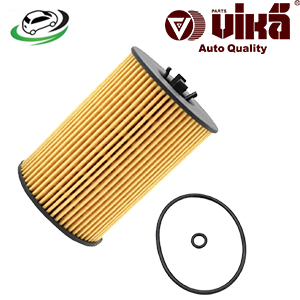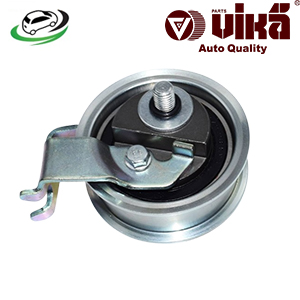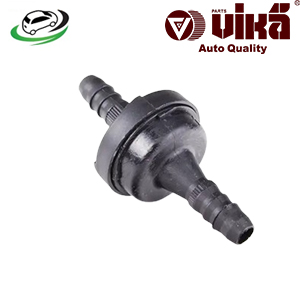-19%
Get Vacuum Check Valve Audi B5 A4 1.8T/ B5 S4 2.7T/ B6 A4 1.8T/ C6 S6 V10 5.2L/ TT MKI / VW New Beetle/ Passat B5 058905291K
The vacuum check valve is a critical component in many automotive systems, particularly those involving vacuum-operated mechanisms. Its primary function is to regulate and maintain vacuum pressure within a specific range, preventing backflow and ensuring the proper operation of various engine and emission control systems. Understanding its design, functionality, importance, and common issues can help in maintaining vehicle performance and efficiency.
1. Design and Structure
The vacuum check valve is a small, often cylindrical device made from metal, plastic, or a combination of both. It is designed to control the flow of vacuum in a system by allowing air to pass in one direction while preventing it from flowing backward. Key components of a vacuum check valve include:
- Housing: The outer casing of the valve, usually made from durable plastic or metal, which houses the internal components and ensures that the valve can withstand engine vibrations and environmental conditions.
- Valve Mechanism: The internal mechanism of the valve, typically consisting of a spring-loaded diaphragm or a ball-and-seat arrangement. This mechanism opens and closes based on the direction of vacuum pressure.
- Ports: The valve has at least two ports—an inlet and an outlet. These ports are designed to connect to the vacuum lines in the vehicle’s system.
- Spring: In many designs, a spring is used to hold the valve mechanism in place and regulate the amount of vacuum required to open the valve.
- Diaphragm or Ball: The diaphragm or ball is a key component that moves to block or allow the flow of vacuum based on pressure changes. It ensures that vacuum pressure is maintained in the desired direction.
2. Functionality
The primary role of the vacuum check valve is to ensure proper vacuum flow and prevent backflow in the vehicle’s vacuum system. Here’s how it works:
- Allowing Forward Flow: When the engine is running, a vacuum is created by the engine’s intake manifold. The vacuum check valve allows this vacuum to flow through the system from the inlet port to the outlet port. This flow is essential for operating various vacuum-dependent systems, such as the brake booster, HVAC controls, and emission control systems.
- Preventing Backflow: When the engine is turned off or when there is a drop in vacuum pressure, the check valve closes to prevent vacuum from flowing backward. This prevents any loss of vacuum pressure that could affect the performance of vacuum-operated components.
- Maintaining System Integrity: By preventing backflow, the check valve ensures that vacuum pressure is maintained in the intended direction, which is crucial for the proper functioning of systems like the brake booster. If vacuum pressure were to flow backward, it could cause the brake booster to lose assist, making the brakes harder to operate.
3. Importance in Engine Operation
The vacuum check valve is crucial for several reasons:
- Ensures Proper Brake Function: The brake booster relies on vacuum pressure to assist in braking. A malfunctioning check valve can cause a loss of brake assist, leading to increased braking effort and reduced safety.
- Maintains HVAC System Performance: Many vehicles use vacuum to control various functions in the heating, ventilation, and air conditioning (HVAC) system. A faulty check valve can result in improper operation of HVAC controls, affecting cabin comfort.
- Controls Emission Systems: Vacuum is used in emission control systems to operate components such as the EGR (exhaust gas recirculation) valve and PCV (positive crankcase ventilation) valve. Proper vacuum regulation is necessary for these systems to function correctly and meet emission standards.
- Prevents Vacuum Leaks: By maintaining vacuum pressure and preventing backflow, the check valve helps prevent vacuum leaks that can affect engine performance and fuel efficiency.
4. Types of Vacuum Check Valves
There are several types of vacuum check valves, each designed for specific applications and requirements:
- Inline Check Valve: This is the most common type, installed directly in the vacuum line. It allows vacuum to flow in one direction while blocking backflow. Inline check valves are often used in various vehicle systems.
- One-Way Check Valve: A one-way check valve allows vacuum to flow in one direction and is commonly used in applications where backflow needs to be strictly prevented. It is similar to an inline check valve but may have different designs for specific applications.
- Integrated Check Valve: In some designs, the check valve is integrated into other components, such as vacuum hoses or connectors. These integrated valves offer a compact solution for vacuum control and are often used in OEM applications.
- Adjustable Check Valve: Some vacuum check valves allow for adjustments to the vacuum pressure at which they open or close. These valves are used in applications where precise vacuum control is required.
5. Common Issues and Maintenance
While vacuum check valves are generally reliable, they can encounter issues that affect their performance. Common problems include:
- Clogs and Debris: Over time, dirt and debris can accumulate inside the check valve, affecting its ability to open and close properly. Regular inspection and maintenance can help prevent clogging issues.
- Seal Wear: The seals inside the check valve can wear out due to exposure to heat and pressure. Worn seals can lead to vacuum leaks and reduced performance.
- Spring Failure: The spring that controls the valve mechanism can become weak or break, affecting the valve’s ability to regulate vacuum pressure.
- Cracks and Damage: Physical damage to the valve housing, such as cracks or breaks, can compromise the valve’s function and lead to vacuum leaks.
Maintenance Tips:
- Regular Inspection: Periodically inspect the vacuum check valve for signs of wear, damage, or leakage. Ensure that the valve and its connections are secure and free of debris.
- Replace When Necessary: If the vacuum check valve shows signs of malfunction or if it is not functioning correctly, replace it with a new one. Using a high-quality replacement valve that matches the vehicle’s specifications is crucial for optimal performance.
- Check for Leaks: Ensure that there are no vacuum leaks in the system by checking the vacuum lines and connections. Leaks can affect the performance of the check valve and the overall vacuum system.
- Keep the System Clean: Regular maintenance of the vehicle’s vacuum system, including cleaning and inspecting vacuum lines, can help prevent issues with the check valve.
6. Replacement and Installation
Replacing a vacuum check valve is a straightforward process, but it requires attention to detail to ensure proper installation:
- Identify the Location: Locate the vacuum check valve in the vehicle’s vacuum system. It is usually connected to a vacuum line and may be found near the intake manifold or other components.
- Remove the Old Valve: Disconnect the vacuum lines from the old check valve. Depending on the design, you may need to remove any clamps or fasteners securing the valve in place. Carefully remove the old valve from the system.
- Install the New Valve: Position the new vacuum check valve in place, ensuring that it is oriented correctly. Reattach the vacuum lines and secure the valve with any necessary clamps or fasteners.
- Check for Proper Operation: After installing the new valve, start the engine and check for proper operation. Ensure that the vacuum system is functioning correctly and that there are no leaks around the valve.
7. Performance and Aftermarket Options
For those seeking enhanced performance or specific features, there are aftermarket vacuum check valves available:
- High-Performance Valves: Aftermarket high-performance vacuum check valves offer improved durability and efficiency, suitable for high-performance or racing applications.
- Precision Valves: Some aftermarket valves offer precise control over vacuum pressure, which can be beneficial in applications requiring exact vacuum regulation.
- Durable Materials: Aftermarket valves may use advanced materials for better resistance to heat, pressure, and environmental conditions, extending the valve’s lifespan.
Follow us on Facebook for more parts.



